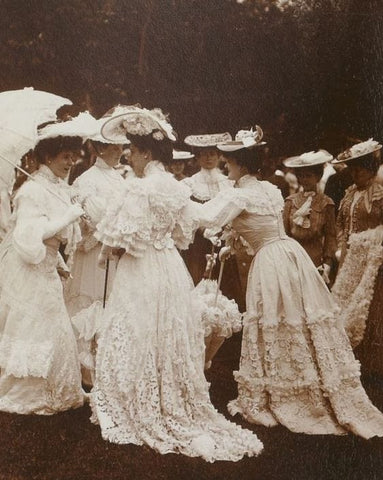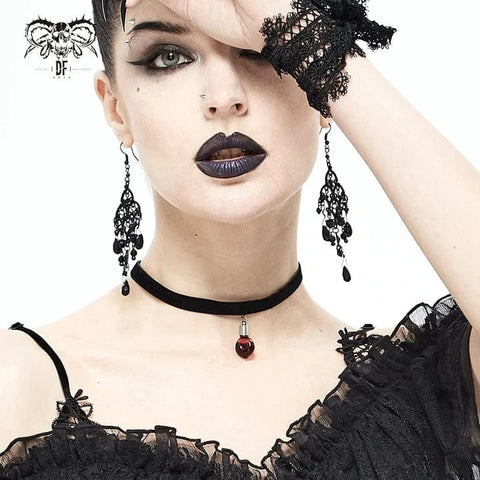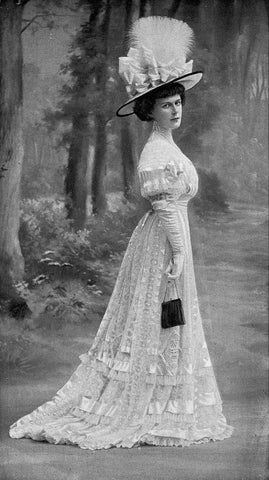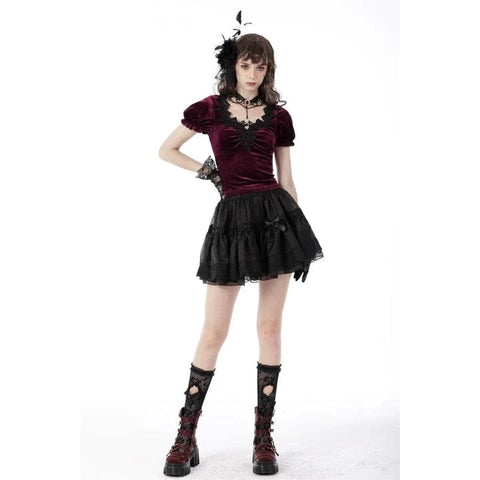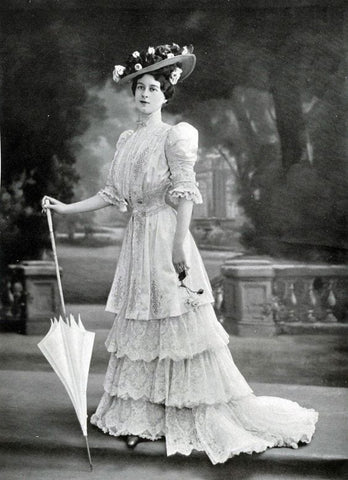The Victorian era, spanning from 1837 to 1901, was a time of significant social, economic, and cultural change. It was also an era marked by conspicuous displays of wealth and a rigid class structure. The clothing worn by the wealthy elite during this period was a crucial aspect of their identity, serving as a symbol of status, taste, and adherence to societal norms. In this blog post, we will explore the opulent world of Victorian fashion and unravel the layers of luxury that adorned the affluent members of society.
An Overview of the Victorian Era
The Victorian era, named after Queen Victoria of England, was a period of profound social, cultural, and technological change that spanned the years 1837 to 1901. This fascinating chapter in history witnessed the transformation of various aspects of society, from industrial advancements to shifts in cultural norms and values. Join us as we embark on a journey through the Victorian era, exploring its key characteristics and the impact it had on shaping the world.
Queen Victoria's Reign
The Victorian era began with the ascension of a young Queen Victoria to the throne in 1837. Her reign, which lasted for an impressive 63 years, played a pivotal role in defining the era. Queen Victoria became a symbol of stability and continuity during a time of rapid change.
Industrial Revolution
One of the defining features of the Victorian era was the Industrial Revolution. The transition from agrarian economies to industrialized societies brought about significant technological advancements. Factories emerged, and steam-powered machinery revolutionized production processes, leading to increased urbanization and economic growth.
Social and Economic Changes
The Victorian era was marked by profound social and economic changes. The rise of the middle class, along with a growing disparity between the rich and poor, fueled debates about social reform. Issues such as child labor, working conditions, and public health became prominent on the societal agenda.
Cultural Flourish
This period witnessed a flourishing of literature, art, and architecture. Renowned authors like Charles Dickens, the Brontë sisters, and Oscar Wilde captured the essence of Victorian society in their works. The architecture of the time, with its elaborate designs and intricate details, reflected the values and aspirations of the era.
Victorian Morality and Values
The Victorian era was characterized by a strong emphasis on morality and propriety. Social norms were rigid, and there was a pervasive sense of duty and respectability. The era's values were often reflected in literature and art, where themes of virtue and morality were explored.
Scientific Progress
Scientific discoveries and advancements also marked the Victorian era. Charles Darwin's theory of evolution, for example, challenged traditional religious beliefs and had a profound impact on the understanding of human origins. The era saw a growing interest in the natural sciences and exploration.
Colonial Expansion
The British Empire reached its zenith during the Victorian era, with extensive colonial expansion. The acquisition of territories in Africa, Asia, and the Pacific had far-reaching consequences, shaping global politics and economies.
Technological Innovations
The Victorian era was a time of remarkable technological innovation. The development of the telegraph, railways, and advancements in medicine and sanitation transformed daily life. These innovations not only improved communication and transportation but also had a lasting impact on public health.
The Victorian era, with its blend of progress and challenges, laid the groundwork for the modern world. From the Industrial Revolution to the flourishing arts and literature, the Victorian era remains a fascinating period that shaped the course of history. As we reflect on this transformative time, we gain insights into the complexities of societal change and the enduring legacy of an era that continues to influence our world today.
A Glimpse into the Wardrobe of Victorian Aristocracy
The Victorian era, spanning from 1837 to 1901, was a time of elegance, refinement, and strict social hierarchy. The clothing of the Victorian aristocracy reflected not only their social status but also the prevailing values and norms of the time. Let's take a fascinating journey into the wardrobe of the Victorian elite, exploring the intricate details and lavish styles that defined this period.
Layers of Opulence
Victorian fashion was characterized by its elaborate layering, particularly for women. The typical aristocratic woman's outfit consisted of a multitude of layers, starting with a chemise, corset, petticoats, and finally the outer dress. These layers were not only a display of wealth but also a reflection of the societal expectation of modesty.
Corsetry: The Essence of Elegance
The corset was a defining element of Victorian fashion, shaping the silhouette into an hourglass figure. Made of whalebone and tightly laced, the corset not only provided support but also emphasized the smallness of the waist—a symbol of beauty and femininity. However, it came at a cost, often causing health issues for those who wore them regularly.

Exquisite Fabrics and Ornate Embellishments
Aristocratic fashion embraced luxurious fabrics such as silk, satin, and velvet. Dresses were adorned with intricate lace, ribbons, and embroidery, showcasing the wealth and status of the wearer. Deep, rich colors like burgundy, emerald green, and royal blue were favored, adding to the regal aura of the aristocracy.
The Dapper Gentleman
Victorian gentlemen were no less concerned with fashion. Tailored suits with frock coats, waistcoats, and cravats were staples of the aristocratic man's wardrobe. Fabrics like wool and tweed were popular, and attention to detail in tailoring was crucial. Top hats and walking sticks completed the look, exuding an air of sophistication.
Lavish Ladies
Victorian women of wealth were adorned in intricate and voluminous dresses that embraced the hourglass silhouette. Corsets played a pivotal role in achieving the desired shape, cinching the waist to create an exaggerated curvature. Layers of petticoats and bustles added volume to the skirts, while delicate fabrics like silk, satin, and velvet were employed for their luxurious gowns. Elaborate lace, frills, and ruffles adorned necklines and cuffs, accentuating the femininity and social standing of the wearer.
Accessories and Adornments
Aristocrats of the Victorian era were known for their love of accessories. Women adorned themselves with gloves, parasols, and intricate jewelry, including cameos and pearls. Men, on the other hand, sported pocket watches, cufflinks, and monocles, further accentuating their refined taste.
Footwear: The Finishing Touch
Footwear played a significant role in completing the Victorian ensemble. Women wore high-heeled boots, often buttoned or laced, while men favored polished leather shoes. Both genders sought to showcase their social standing through the quality and style of their footwear.
Changing Fashion Trends
As the Victorian era progressed, fashion evolved. The early Victorian era saw an emphasis on large crinolines and hoop skirts, giving way to the more streamlined and bustled silhouettes of the late Victorian period. The influence of Queen Victoria and her changing mourning attire also played a role in shaping fashion trends.
The wardrobe of Victorian aristocracy was a reflection of a society deeply rooted in tradition, social hierarchy, and the pursuit of refined aesthetics. The elaborate attire not only showcased the wealth of the aristocrats but also served as a visual language communicating their adherence to societal norms and expectations. Exploring the intricacies of Victorian fashion provides us with a glimpse into a bygone era where clothing was not just a practical necessity but a powerful expression of identity and status.
The Enduring Legacy of Victorian Fashion
In the ever-evolving world of fashion, trends come and go, but some styles have a timeless allure that transcends generations. One such era that continues to influence contemporary fashion is the Victorian era. The 19th-century Victorian fashion, characterized by its opulence, intricate details, and structured silhouettes, has left an indelible mark on the fashion landscape. In this blog, we delve into the enduring legacy of Victorian fashion and explore how its echoes can still be seen and celebrated in the styles of today.
The Essence of Victorian Fashion
The Victorian era, spanning from the 1830s to the early 1900s, was a period of significant societal and industrial changes. The fashion of the time reflected the complex values of the era, blending modesty with a penchant for lavish ornamentation. The corseted bodices, voluminous skirts, and intricate lacework were emblematic of the Victorian aesthetic. These elements created an unmistakable silhouette that has become iconic and easily recognizable even in contemporary times.
Victorian Influences in Contemporary Fashion
Lace and Intricate Details:
The delicate artistry of lace, a hallmark of Victorian fashion, continues to be a cherished element in modern clothing. Designers often incorporate lace into dresses, blouses, and accessories, adding a touch of timeless elegance to contemporary wardrobes.
High Necks and Ruffled Collars:
The Victorian penchant for high necklines and ruffled collars has found its way back into modern fashion. Blouses and dresses featuring these classic details evoke a sense of vintage charm while remaining relevant and stylish.
Corsetry and Hourglass Silhouettes:
While the rigid corsets of the Victorian era may not be as prevalent today, the emphasis on creating a defined waist and an hourglass silhouette is a nod to Victorian fashion. Modern adaptations, such as corset-style belts and fitted dresses, pay homage to this timeless aesthetic.
Rich Fabrics and Jewel Tones:
Victorian fashion was synonymous with opulent fabrics like velvet and silk, often in deep jewel tones. Today, designers draw inspiration from this rich color palette and luxurious fabrics to create garments that exude sophistication and regality.
Vintage-Inspired Accessories:
Accessories played a crucial role in Victorian fashion, and their influence persists in contemporary style. From cameo brooches to statement hats and gloves, these accessories add a touch of Victorian flair to modern outfits.
Cultural Impact and Redefining Femininity
Beyond its aesthetic influence, Victorian fashion has played a role in reshaping societal perceptions of femininity. The era's emphasis on modesty and propriety has sparked ongoing conversations about the intersection of fashion, identity, and empowerment. In embracing Victorian-inspired styles, individuals today can explore a fusion of tradition and modernity, finding new ways to express themselves while honoring the past.
The legacy of Victorian fashion endures in the fabric of contemporary style. Its influence can be seen in the details of clothing, the choice of fabrics, and the overall appreciation for the elegance of a bygone era. As we continue to draw inspiration from the Victorian aesthetic, we celebrate not only the enduring allure of this period but also the dynamic nature of fashion, where the past seamlessly integrates with the present, creating a tapestry of timeless beauty.
The clothing worn by wealthy individuals in the Victorian era was more than just fabric and thread; it was a statement of status and a reflection of societal norms. The attention to detail, the use of luxurious fabrics, and the adherence to the prevailing fashion trends all contributed to the visual language of Victorian opulence. The legacy of Victorian fashion continues to captivate us, offering a glimpse into a bygone era where clothing was not merely a necessity but a powerful expression of affluence and social standing.


